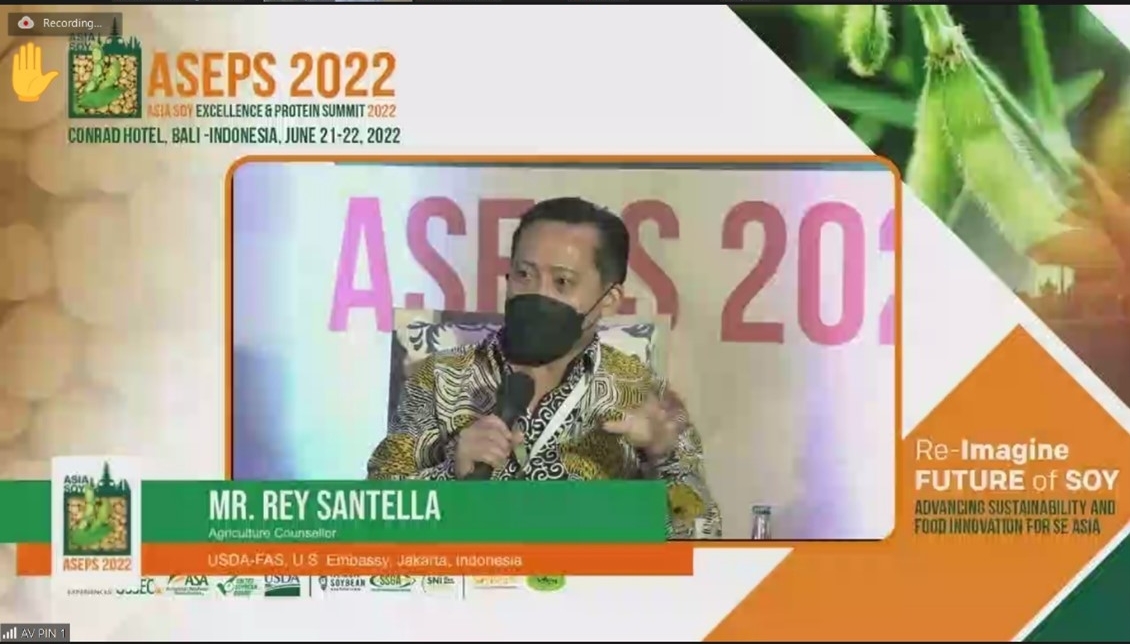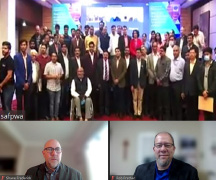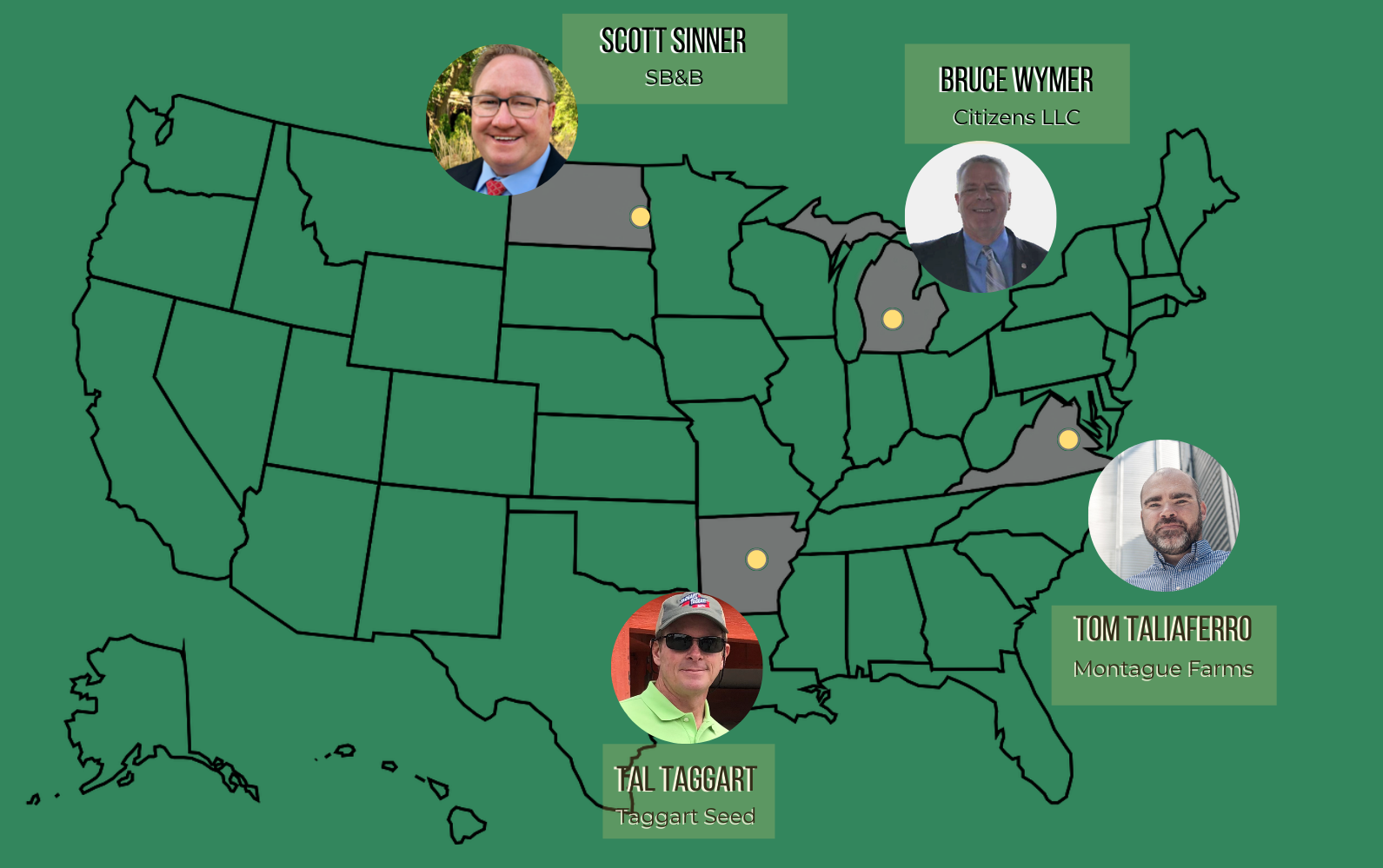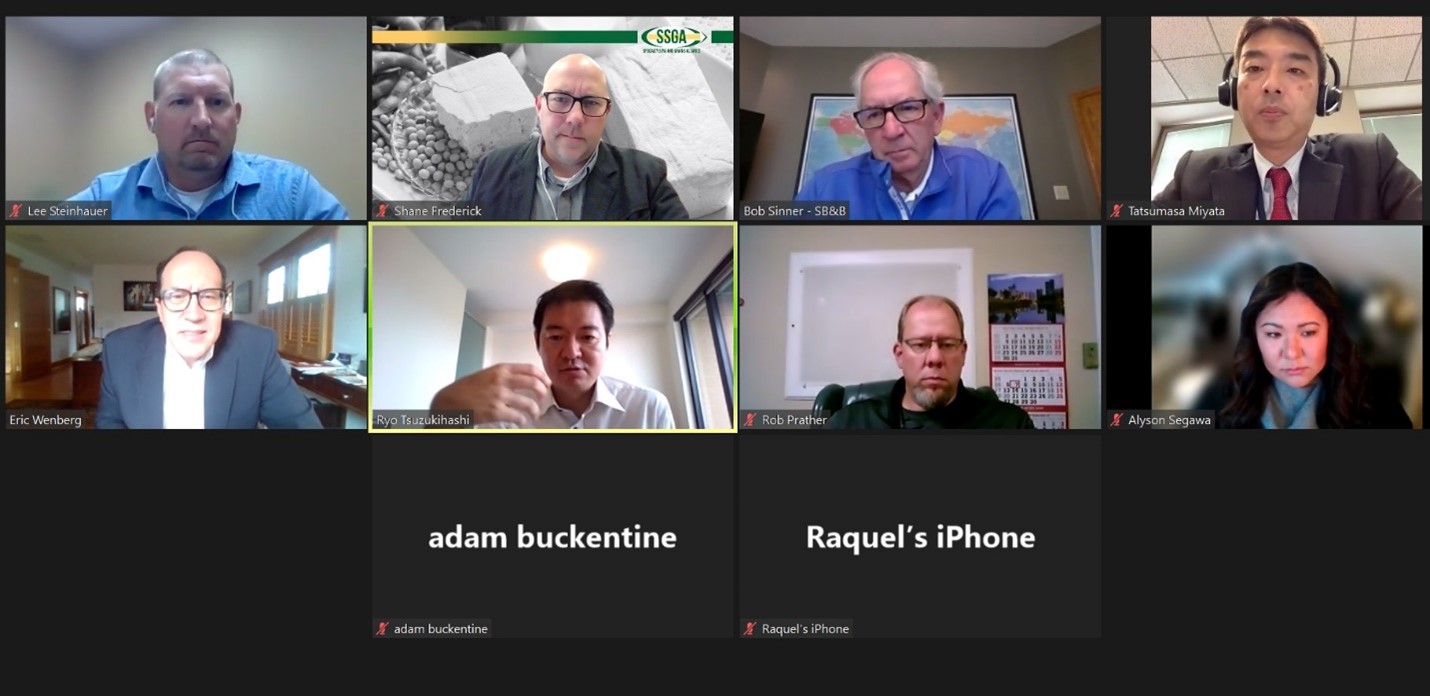ST. LOUIS – Demand was the theme of the U.S. Soy Global Trade Exchange & Specialty Grains Conference, which took place here Tuesday-Thursday.
Global demand for U.S. Soy overall, demand for Identity Preserved soy and specialty grains and demand for some real human interaction.
After COVID-19 forced the 2020 GTE to be all virtual, the 2021 show was a hybrid event, with about 300 attendees gathering safely in steamy St. Louis and another 900 joining online from 59 countries.
“We’ve been waiting for more than 18 months to gather again in person to connect, reconnect and do business,” said Eric Wenberg, executive director of the Specialty Soya and Grains Alliance (SSGA), which co-hosted the GTE with the U.S. Soybean Export Council. “At the same time, we had people on the virtual platform networking, connecting to businesses and making sales. India was pinging businesses from the time the show started.”
Following a night out with the crowd at Busch Stadium for a baseball game between the hometown St. Louis Cardinals and the Detroit Tigers, the GTE kicked off early Wednesday morning with a robust agenda. SSGA Chairman Bob Sinner joined USSEC Chair Monte Peterson on the stage to get things started.
“The value of our partnerships is immeasurable,” Sinner said, “and by hosting events like this one, we can learn directly from you about your biggest challenges and who we might address any concerns. To us, it’s clear that collaboration is the best way to make things happen. That’s true whether you’re working with your peers on a neighboring farm or on another continent.”
Sinner and Wenberg participated in a media briefing, along with Peterson and USSEC CEO Jim Sutter, and talked about transportation challenges SSGA member exporters are facing, how SSGA has innovated to make certain business connections continued during COVID and the U.S. Identity Preserved system and the demand for IP soya and specialty grains.
“The demand for identity preserved, non-GMO field crops from the U.S. has been staggering; the demand currently exceeds supply,” said Sinner, who is president of SB&B Foods. “Our customers have realized the benefits of sourcing these crops and their specific IP qualities for food manufacture because they have realized how it improves their retail products and sales.”
Sinner continued that demand is growing over a variety of sectors, including the pet food industry, and that SSGA is encouraging more U.S. growers to consider identity preserved production.
The in-person and virtual GTE audience heard from globally recognized industry leaders and experts about global supply and demand trends, trade policy updates, as well as research on the quality and sustainable aspects of U.S. soy and specialty grains.
Wenberg led a session on the future of food featuring speakers Jon Tanaka, senior project manager of scientific and regulatory affairs for Morinaga Nutritional Foods; Dina Fernandez, global director, protein nutrition solutions for ADM; and Tony Andrew, protein solutions business unit leader for International Flavors & Fragrances.
“Consumers are embracing plant-based diets, and there are opportunities for all plant-protein sources – including soy,” Andrew said, adding that consumer perception of soy over the last several years has grown, especially after exposure to further education about soy.
Tanaka, whose company produces shelf-stable tofu, said the market for tofu and tempeh has grew by nearly 41% from 2019 to 2020.
“People do want to become healthy; they want to eat better,” Tanaka said. “Since the beginning of the pandemic there’s been a shift in consumer purchasing toward natural and organic products.”
Another highlight session featured Commissioner Carl Bentzel of the Federal Maritime Commission, who appeared with SSGA Secretary/Treasurer Darwin Rader, international sales manager for Zeeland Farm Services, and Bryan Paskewicz, account executive for Ray-Mont Logistics, to discuss the challenges facing exporters who ship by container.
“We are, right now, at a crisis in ocean shipping as a result of the things that went on over the last year,” Bentzel said, adding that the supply chain hasn’t been this congested since World War II.
A small agency with just 120 employees, the FMC is taking action where it can, Bentzel said. A recent executive order by President Biden encourages greater emphasis on FMC enforcement of the Shipping Act. However, he added, that the crisis could continue well into 2022.
“We’re here to find solutions to get us exports overseas,” Paskewicz said. “Foreign countries need food products; they need agricultural products.”
Another SSGA breakout session featured exporters reporting on progress and conditions for Identity Preserved non-GMO crops around the country. Ryan Koory, director of economics for Mercaris, moderated the session, which included presentations from Rick Brandenburger, president of Richland IFC and SSGA board director; Chase Holoubek, lead merchant for Scoular; and Brent Rogers, general manager for Rogers Grain.
The GTE also featured an in-person and virtual trade show featuring several exhibitors representing the soy, specialty grains and allied industries.
The 2021 Global Trade Exchange & Specialty Grains Conference featured several key sponsors, including platinum sponsors the Illinois Soybean Association, Iowa Soybean Association, Minnesota Soybean Research & Promotion Council, North Dakota Soybean Council, Ohio Soybean Council and Wisconsin Soybean Marketing Board. The Missouri Soybean Merchandising Council and South Dakota Soybean Research & Promotion Council were Gold sponsors. Scoular was a Bronze Sponsor, while Hang Tung Resources was the key card sponsor and SGS sponsored the conference wi-fi.
“The North Dakota Soybean Council sponsors the Global Trade Exchange to facilitate global trade relationships for North Dakota soybeans,” said JP Lueck, a soybean farmer from Spiritwood, N.D. “Events like the GTE allow North Dakota soybean farmers like me to better understand our customers’ needs and produce the quality soy they have come to know and expect from North Dakota.”
Check out photos from the GTE on the SSGA Facebook page.
Click here to learn more about the GTE.
 SSGA had the opportunity to weigh in on that concern during the conference, hosted by the U.S. Soybean Export Council (USSEC) June 21-22 in Bali. Presenting virtually, SSGA Executive Director Eric Wenberg and Chair Rob Prather briefed about 150 attendees on current identity preserved (IP) crop production issues, logistics and container shipping during the hybrid event. Steve Peach, a Michigan farmer and member of the Michigan Soybean Committee, and Troy Berndt, a grower relations specialist in Wisconsin, updated attendees on the 2022 growing season in their respective states/regions.
SSGA had the opportunity to weigh in on that concern during the conference, hosted by the U.S. Soybean Export Council (USSEC) June 21-22 in Bali. Presenting virtually, SSGA Executive Director Eric Wenberg and Chair Rob Prather briefed about 150 attendees on current identity preserved (IP) crop production issues, logistics and container shipping during the hybrid event. Steve Peach, a Michigan farmer and member of the Michigan Soybean Committee, and Troy Berndt, a grower relations specialist in Wisconsin, updated attendees on the 2022 growing season in their respective states/regions.
 The event was held in coordination between SSGA, the U.S. Soybean Export Council (USSEC) and the China Chamber of Commerce of Import and Export of Foodstuffs, Native Produce and Animal By-Products (CFNA).
The event was held in coordination between SSGA, the U.S. Soybean Export Council (USSEC) and the China Chamber of Commerce of Import and Export of Foodstuffs, Native Produce and Animal By-Products (CFNA). The petitioners in the case were the Organic Soybean Processors of America (OSPA) and the following processors: American Natural Processors LLC (S.D.), Organic Production Services LLC (N.C.), Professional Proteins Ltd. (Iowa), Sheppard Grain Enterprises LLC (N.Y.), Simmons Grain Co. (Ohio), Super Soy LLC (Wis.) and Tri-State Crush (Ind.).
The petitioners in the case were the Organic Soybean Processors of America (OSPA) and the following processors: American Natural Processors LLC (S.D.), Organic Production Services LLC (N.C.), Professional Proteins Ltd. (Iowa), Sheppard Grain Enterprises LLC (N.Y.), Simmons Grain Co. (Ohio), Super Soy LLC (Wis.) and Tri-State Crush (Ind.). Newly elected SSGA Chairman Rob Prather was a co-chair for the virtual session and also presented on buying Identity Preserved field crops from the United States. SSGA Manager of Strategic Programs Shane Frederick then presented on the new U.S. Identity Preserved Assurance Plan and brand mark, which was launched on Dec. 2, and SSGA University.
Newly elected SSGA Chairman Rob Prather was a co-chair for the virtual session and also presented on buying Identity Preserved field crops from the United States. SSGA Manager of Strategic Programs Shane Frederick then presented on the new U.S. Identity Preserved Assurance Plan and brand mark, which was launched on Dec. 2, and SSGA University. The update was an opportunity to share information, including 2021 post-harvest crop conditions and an outlook for 2022. Presenters represented different companies in different regions of the United States.
The update was an opportunity to share information, including 2021 post-harvest crop conditions and an outlook for 2022. Presenters represented different companies in different regions of the United States. SSGA was represented by Sinner, Vice-Chairman Rob Prather, Secretary/Treasurer Darwin Rader and board members Adam Buckentine and Raquel Hansen, along with Executive Director Eric Wenberg, Technical Adviser for North Asia Alyson Segawa and SSGA staff Lee Steinhauer and Shane Frederick.
SSGA was represented by Sinner, Vice-Chairman Rob Prather, Secretary/Treasurer Darwin Rader and board members Adam Buckentine and Raquel Hansen, along with Executive Director Eric Wenberg, Technical Adviser for North Asia Alyson Segawa and SSGA staff Lee Steinhauer and Shane Frederick.

